Menu
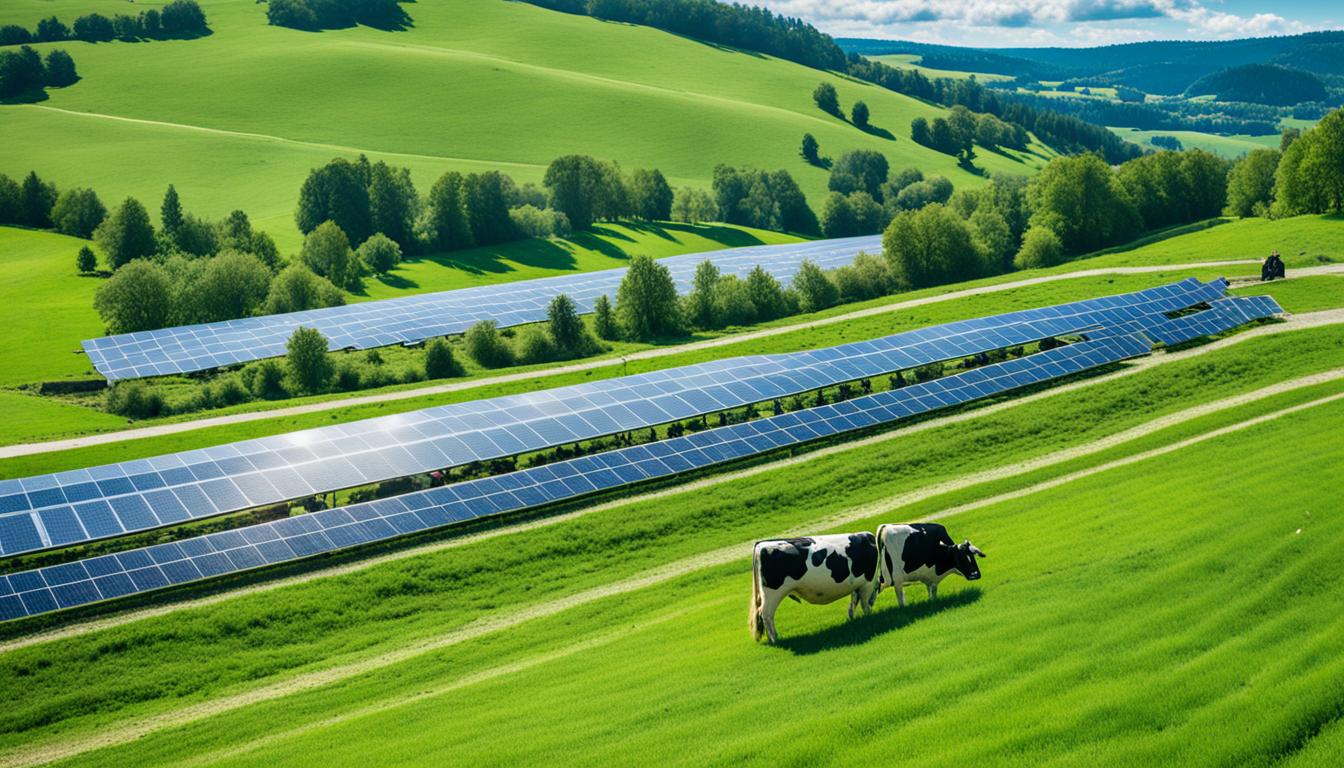
Did you know nearly 70% of the world’s freshwater goes into farming? Sustainable livestock farming deals with the rising need for resources without harming the planet. It’s all about making money while considering our environmental impact.
The United Nations talks about big problems like people being pushed out of their homes, throwing away food, and gases from waste in their latest report. Farms use the most water but can cut back through sustainable methods. This helps save water and energy, cuts down on waste, protects farmers’ incomes, and makes our food system stronger. By going green in farming, we keep our world healthy for the future.
Sustainable livestock farming is key to a balanced approach. It looks at economics, the environment, and the well-being of people. This method not only ensures long-term economic success but also takes care of our planet and the local communities.
One big benefit of sustainable livestock farming is its strong economy. Methods like agroforestry and conservation farming make income more stable. These approaches help farmers earn money in different ways, reducing the impact of market changes.
Looking at the environment, sustainable farming is a win for all. It improves soil, saves water, and cuts down on carbon. By doing this, we help the planet thrive and make the most of natural resources.
Sustainable farming does more than make money and help the planet. It also supports a fair society. This involves giving workers fair pay and safe conditions, being active in the local community, and responding to ethical consumer needs. By doing so, farmers strengthen their communities and meet new sustainability rules.
Combining economic success, caring for animals in the right way, and social responsibility is important. This approach supports using resources wisely, reducing waste, and involving communities. It’s crucial for a bright future in agriculture.
Our goal in livestock sustainability is to use several key practices. These help our planet, our money, and our communities. We focus on managed grazing, using water well, and looking after our animals wisely. This way, we meet the growing need for animal products in a green and fair way.
Using better livestock methods is important to lower their big carbon footprint. We do this by improving what our animals eat, adding green energy, and practising smart farming. These steps help our environment and encourage smart investments. Thus, it brings in money that cares about the climate.
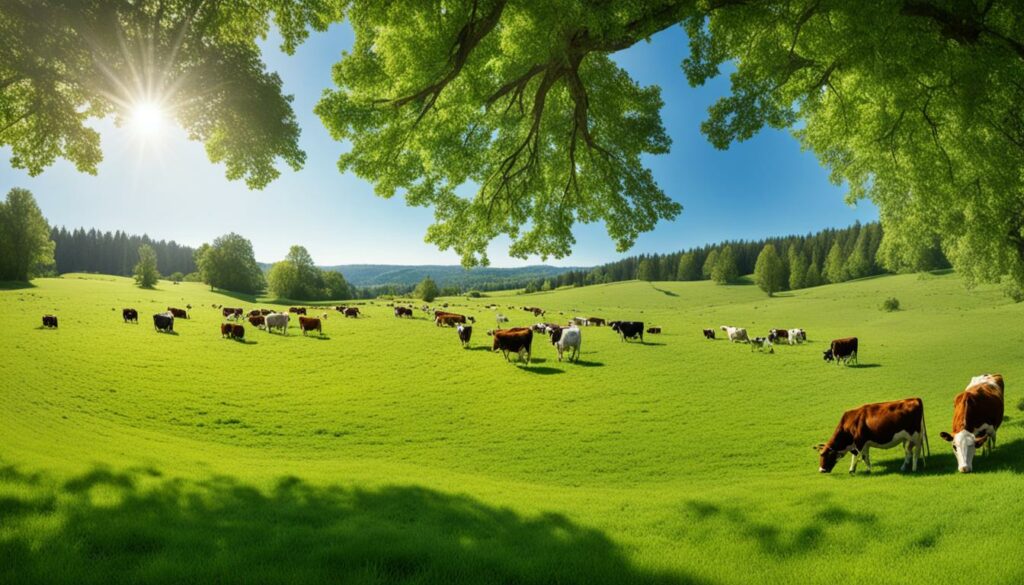
To be truly sustainable, we must think about animal care and the environment together. This means making better food for the animals and using clean energy. It also includes being wise with water. These are all essential to keep our animals healthy and our farms running well for the long term.
We are dedicated to making livestock farming kind to the earth. We use green ways and smart climate steps. This helps make a strong, green livestock industry. It supports our future goals while also helping the economy and our communities.
Soil management in sustainable livestock farming is key. Good strategies keep soil healthy, leading to better crops and more livestock productivity. Methods like cover crops and crop rotation keep soil from eroding and boost crop yields.
Cover crops are vital for keeping soil healthy. They improve soil fertility and suppress weeds, reducing erosion. This approach helps improve soil structure and ensures better crop growth.
Crop rotation is important too. It means planting different crops in the same field at different times. This reduces pests and enriches soil, keeping the land fertile. It also cuts down on soil erosion, making farming more sustainable.
Reduced tillage helps protect the soil. It keeps moisture in and soil structure strong, reducing erosion. This method supports a healthy ecosystem for both plants and animals. It’s a big part of managing soil sustainably.
| Method | Key Benefits |
|---|---|
| Cover Crops | Improves soil fertility, suppresses weeds, reduces erosion |
| Crop Rotation | Diversifies crops, enriches soil nutrients, reduces pests |
| Reduced Tillage | Minimises soil disturbance, conserves moisture, protects structure |
Crop rotation is key in looking after the land. By changing which crops grow each year, the fields stay healthy. This helps the soil and the animals that eat from it stay well.
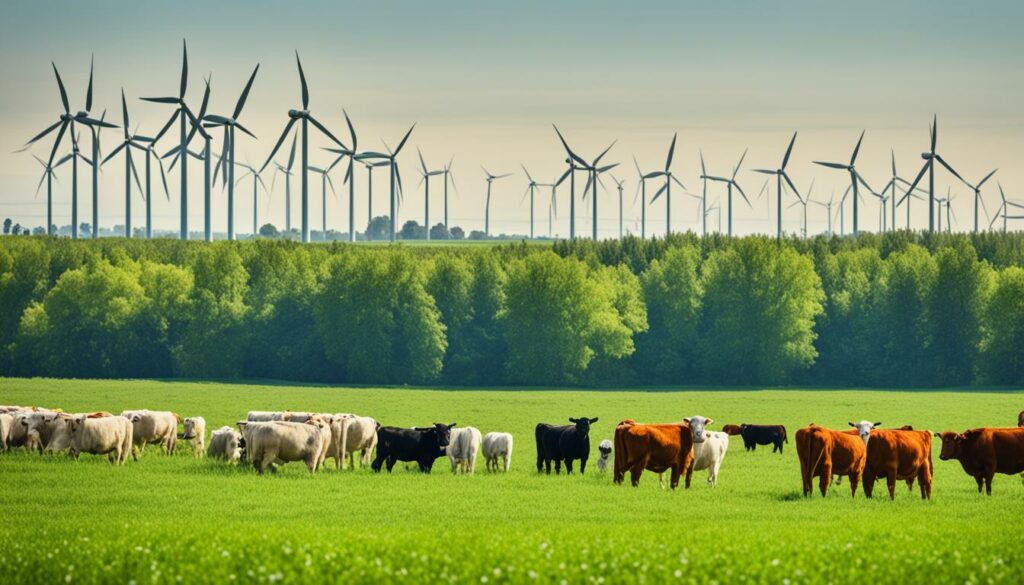
Rotating crops boosts the soil’s health. It keeps the soil rich by spreading out the use of different natural nutrients. This way, the soil stays strong and helps the plants grow better, season after season.
Switching crops each year is great at keeping away bugs and plant sicknesses. It confuses pests and diseases, making it hard for them to survive. This means fewer chemicals are needed to grow healthy crops. And these good crops make better food for livestock, helping farms stay strong.
Organic livestock farming shows a deep care for the environment. It avoids using chemicals. Instead, it chooses natural ways to grow animal feed. This helps keep our planet healthy. It also aids in making food production more sustainable.
It’s not just the lack of chemicals that’s important. This kind of farming also helps in other ways. For example, it reduces soil and water pollution. It also cuts down on greenhouse gas emissions. These efforts fit well with the wider goal of organic farming. They all aim to keep our environment clean and safe.
This form of farming also cares about how it treats animals. It ensures they live in good, humane conditions. This isn’t just for the animals’ sake. It also helps in making sure we have enough healthy food. This happens in a farming system that works well with nature.
By doing this, organic farming supports the planet’s health in many ways. It helps keep a variety of plants and animals on the farm. Also, it makes sure the way we farm can continue for the next generations. These are steps towards a future where farming and nature work in harmony.
Agroforestry joins trees with farming to boost eco and economic strength. It helps save nature and makes farms more stable. Mixing trees with farms helps save different plants and animals.

Agroforestry lets trees, crops, and animals work well together. It offers shade for animals, keeps soil healthy, and stops it from washing away. Adding trees to farms creates strong places for many living things to thrive.
Agroforestry protects many types of animals and plants. Trees prevent strong winds, make soil better, and give homes to wildlife. By farming this way, we keep the earth under our feet alive and strong.
Agroforestry boosts farm earnings in different ways. By selling wood, fruits, or animal food, farmers get more money. It also helps them deal better with ups and downs in the market. This way of farming is good for making money and caring for the environment.
| Aspect | Benefits | Examples |
|---|---|---|
| Agroforestry Systems | Improved soil quality, reduced erosion | Silvopasture, Alley Cropping |
| Biodiversity Conservation | Enhanced habitat for wildlife, balanced ecosystems | Native tree plantations, Forest gardening |
| Economic Advantages | Additional income, market stability | Timber sales, Fruit and nut production |
| Agro-Ecological Benefits | Improved soil microbiomes, strengthened farm resilience | Windbreaks, Soil enrichment |
Agroforestry in livestock farming shows smart thinking. It mixes good business with looking after nature. This way, farmers help the earth and their own futures.
Conservation agriculture is a careful way of farming that doesn’t disrupt the soil much. It keeps the ground covered and uses many different crops over time. This approach is great for farmers and the planet.
Conservation farming shows us how important it is to farm in a way that keeps the land healthy. Instead of disturbing the soil a lot, methods like no-till farming are used. This lowers the risk of the topsoil washing away. As a result, crops grow better and the land stays strong.
To stop the soil from eroding and keep it moist, covering it is key. Methods like mulching and planting cover crops help a lot. They create a small, rich ecosystem in the soil. This makes the ground better at holding water.
Also, switching between different crops each season helps in many ways. It stops pests from getting too comfortable and encourages more plant and animal variety. This process makes the soil healthier and the farm more sustainable.
Conservation farming really shines in saving water too. It makes the soil and water work well together so the farm doesn’t need as much water. This is a big win for both farming and the environment. It keeps the land healthy for the long haul.
By following these smart farming methods, we’re setting up a better future. It’s about caring for the Earth while still being able to grow food for everyone.
Integrated Pest Management (IPM) is key for a green approach in farming. It uses methods such as biological control and careful farming. This way, we use less pesticide, making the area safe for animals.
In IPM, we use nature to fight pests. This means using natural enemies of pests. It cuts down on chemicals and helps make a balanced environment. Such an environment is good for both helpful and harmful creatures. As a result, the farm is better for raising healthy animals.
IPM aims to use less pesticide. It mixes bio control with better farming practices. This way, we have a natural way to keep pests away, without harming the environment. The farm becomes healthier for the animals, which grow in a happy, natural place.
The CSA model is changing how we see traditional livestock farming. It brings farmers and consumers together. This way, local food systems support sustainable farming. They make sure fresh, local food gets to our tables.
One key thing CSA does is help farmers financially. It allows farmers to get money upfront from farm-to-consumer partnerships. This makes it easier for them to plan their work. For consumers, this means they can trust their food is made the right way.
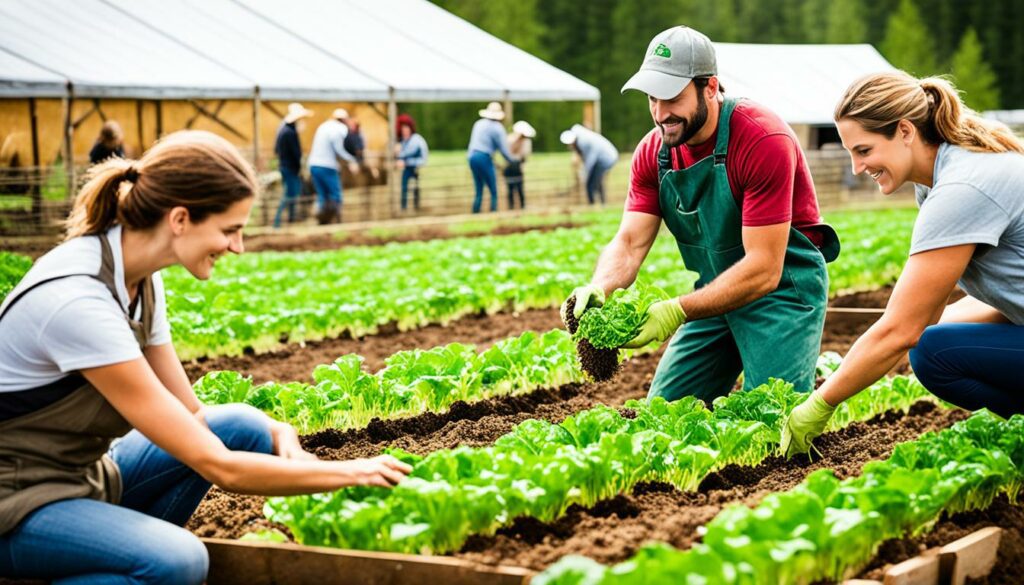
CSA does more than change how we buy food. It creates a link between people and farms. This link helps folks learn about the hard work in farming. It makes them want to keep local food systems going and to back eco-friendly farming efforts.
| Benefits of CSA | Farmer Advantages | Consumer Advantages |
|---|---|---|
| Financial Security | Upfront investments provide stability | Guaranteed share of fresh produce |
| Community Engagement | Stronger community connections | Increased awareness of farming practices |
| Local Food Systems | Support for sustainable practices | Access to local, environmentally friendly produce |
| Farm-to-Consumer Partnerships | Direct sales reduce marketing costs | Closer relationship with food sources |
Precision farming blends agriculture with advanced technology. It uses satellites, GPS, and sensors. This mix helps use resources better and reduces waste.
With these tools, we boost agriculture’s efficiency. Every input improves the output. This way, we don’t use more than needed.
Smart farming technology shows its power in precision farming. There are soil sensors for checking moisture and nutrients. GPS helps guide tractors accurately. Drones offer bird’s-eye views of crops.
Farmers get real-time data for smart decisions. This improves how resources are used.
Introducing smart farming technology increases efficiency. It ensures inputs like water and fertilisers are used exactly where they’re needed. This means less waste.
Doing this boosts crop quality and quantity. It shows how saving resources brings more yield.
Precision farming also cuts costs significantly. It means using less expensive things like water and fertilisers in smart ways. Plus, more productivity and less waste make farming cheaper.
These savings help farms earn more and become more sustainable.
| Aspect | Impact |
|---|---|
| Technological Tools | Enhanced decision-making and resource application |
| Efficiency Gains | Increased productivity and quality |
| Cost Reductions | Lower input costs and higher profitability |
Livestock is key to sustainable food systems, offering many benefits. They provide services like natural manure for fertilisation. In regions without much machinery, they also help as working animals. This makes them fit well into eco-friendly farming.
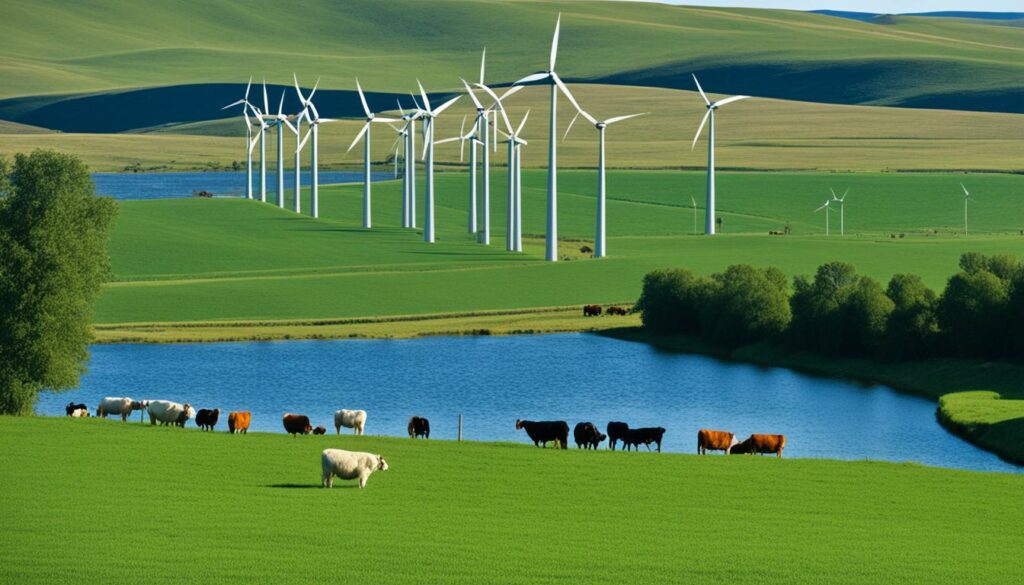
Natural manure is a great way to feed the soil. It uses animal waste to add nutrients without chemicals. This boosts soil health, reduces farming’s impact on the environment, and supports plant growth.
In some areas, using animals to pull ploughs and carts is very useful. This method saves energy and resources, making farming more eco-friendly. It also means less need for machines that burn fossil fuels.
Livestock play a big role in sustainable farming. They help by providing natural fertilisers and working the land. This fits well with using less of our planet’s resources while still being productive.
Maintaining the health of animals is key to sustainable farming. It’s not just about treatment; it’s also about preventing issues. Doing regular health checks helps find problems early. This reduces risks and stops diseases from spreading.
Supporting veterinary care keeps our animals healthy and able to produce. Tracking their health and giving them vaccines protects them and our food. Better ways to stop diseases help look after animals and keep our food supply safe.
Looking after animals well is important for us, too. Veterinary care helps stop diseases that can pass from animals to humans. This connection shows how vital veterinary work is for both animals and people.
New tools and ways to treat animals, like telemedicine, are changing veterinary care for the better. They help care for animals quickly and keep farms productive. So, having strong veterinary care is essential to keeping animals healthy and farming in a sustainable way.
It’s vital to use climate-smart methods in farming. This helps lower the harmful effects of farming on the planet. It also makes farming more ready for changes in the climate. These methods not just cut down on greenhouse gases. They also help agriculture grow in ways that last.
Climate-smart farming makes the whole farm stronger against tough weather. Changing what we feed animals can lower how much methane they make. This makes them healthier and work better. Looking after pastures right can lock up carbon and keep areas for animals strong against wild weather.
Reducing farm emissions is key to fight climate change. Things like giving exact amounts of feed and handling manure better lessen gases like methane. Using solar and wind power lessens the need for fossil fuels, helping to slow down climate change.
| Climate-Smart Practice | Emission Control Benefit | Climate Co-Benefit |
|---|---|---|
| Optimised Pasture Management | Reduces Carbon Emissions | Enhances Soil Carbon Sequestration |
| Precision Feeding | Lowers Methane Output | Improves Animal Productivity |
| Use of Renewable Energy | Decreases Reliance on Fossil Fuels | Supports Sustainable Energy Use |
| Efficient Manure Management | Minimises Nitrous Oxide Emissions | Enhances Fertiliser Efficiency |
By using smart farming, raising animals can become both eco-friendly and profitable. These ways make farming a leader in making our planet healthier and ready for the future. All while making sure farms are strong against changing weather patterns.
Sustainable farming is changing how livestock farming works. It shows how farmers worldwide are adapting and doing well. Stories from places like Latin America and Southeast Asia show the success of eco-friendly farming. They serve as examples for a more sustainable future.
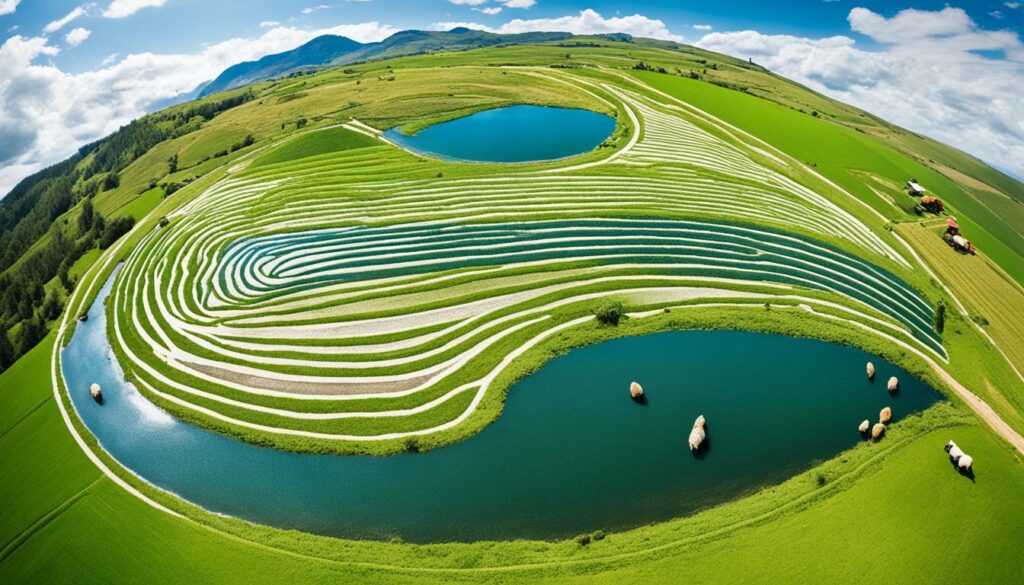
In Argentina, farmers moved to sustainable ways of managing pastures. They used a mix of natural pastures and some planted grasses. This change helped improve the soil and make their farms more productive. Changing where animals graze can greatly help the environment.
The Sahel’s Pastoral Support Project mixes old and new ways to care for livestock. By blending traditional and modern knowledge, they deal with changing climates better. This project, by and for the local people, is a great example of how community support is vital for sustainable farming.
In Vietnam, they focused on caring for animals the right way. This has led to cleaner environments and better health. The changes in how animals are housed and fed, and waste is managed, mean less harm to the planet. Vietnam’s success shows how focusing on sustainability benefits everyone.
These case studies show that sustainable farming works in different places. They light the way for better farming practices. They stress the need for all of us to work together for a sustainable future.
Sustainable livestock systems bring many economic and social upsides. They boost livestock economic growth, helping local areas prosper. This includes steady sustainable farming income for small farmers, making them more resilient to economic ups and downs.
These methods also lift up communities by creating jobs and promoting gender fairness. This helps improve food security and the well-being of the area. By moving towards equitable livestock practices, we make farming fairer and more supportive for all.
| Benefit | Impact |
|---|---|
| Livestock Economic Growth | Steady income and increased financial stability for farmers |
| Social Upliftment in Farming | Job creation, gender equality, and improved food security |
| Equitable Livestock Practices | A more just and inclusive agricultural system |
| Sustainable Farming Income | Resilience against market and environmental shocks |
Sustainable livestock farming balances making money with looking after the Earth and caring for society. It’s crucial as we face more demand for food globally. Everyone needs to protect our resources and back farming that’s good for the planet.
This effort protects not just our future but also helps animal farming become eco-friendlier. It respects wildlife and treats animals well.
All parties—farmers, leaders, backers, and buyers—need to promote farming that lasts. This means saving resources, taking good care of animals, and involving the community. Together, we can build a strong and successful farming industry.
The future of farming sustainably depends on new ideas, green tech, and supporting eco-friendly policies. It promises a fair and eco-friendly way to grow our food. By sticking to these ideas, we can make sure our food system is good for the Earth and us.
Sustainable livestock farming brings both money and environmental care together. It uses methods like agroforestry and community farming. These make sure the soil, water, and the air are looked after well. This way, farmers can earn well while keeping their handling of the land in check.
It keeps the land healthy, uses water well, and cuts carbon emissions. Techniques such as smart grazing and using clean energy lower the industry’s impact on nature.
This method means workers are treated fairly and communities grow stronger. It meets the public’s demand for ethical products, making food systems more balanced and reliable.
There are key methods like careful grazing and looking after manure. These ways aim to make animals live better while using the land wisely.
Managing the soil keeps it and animals healthy. Ways like planting different crops each year, and reducing soil digging help the land stay fertile without harm.
Growing different crops keeps the ground rich and pests away. This means the food for animals is healthier, supporting a strong food chain for livestock.
Organic ways don’t harm the earth with chemicals but use natural ways. It stands up for the food’s health, nature’s balance, and supports a rich mix of life on farms.
Mixing trees with animals or crops helps the earth and brings in extra money. It supports a way of farming for the long term that doesn’t strain the environment.
This farming way is gentle on the land, covering and mixing up what’s grown. It prizes the earth’s health, stopping soil loss and managing water well, keeping farming green.
It’s a smart way to keep pests low without using lots of chemicals. By balancing nature, it keeps animals healthy and cuts down on harmful sprays.
It helps farmers plan better by pre-selling food and ties communities closer to what they eat. This way is fairer to everyone and keeps food local and fresh.
This hi-tech approach makes farming efficient and less wasteful. It helps plants grow better, saves money, and is kind to the earth, fitting well with green agriculture goals.
They help make land richer and work harder, doing jobs machines can’t in some places. This way, farming saves energy and reuses resources, keeping it sustainable.
Good animal care is key not just for farms, but also for what people eat and their health. Looking after animals welll supports long-lasting farming and public health goals.
These include smart feeding and managing animal waste. Also, using renewable power and caring for pastures lower the industry’s greenhouse gas output.
Argentina, Sahel, and Vietnam show great success in green farming. Each place uses clever ways, such as keeping land from turning to desert, sharing old methods, and being careful with how animals are raised.
These systems help poor farmers earn steady money and create jobs. They make farms more able to handle tough times, both in the market and the environment.